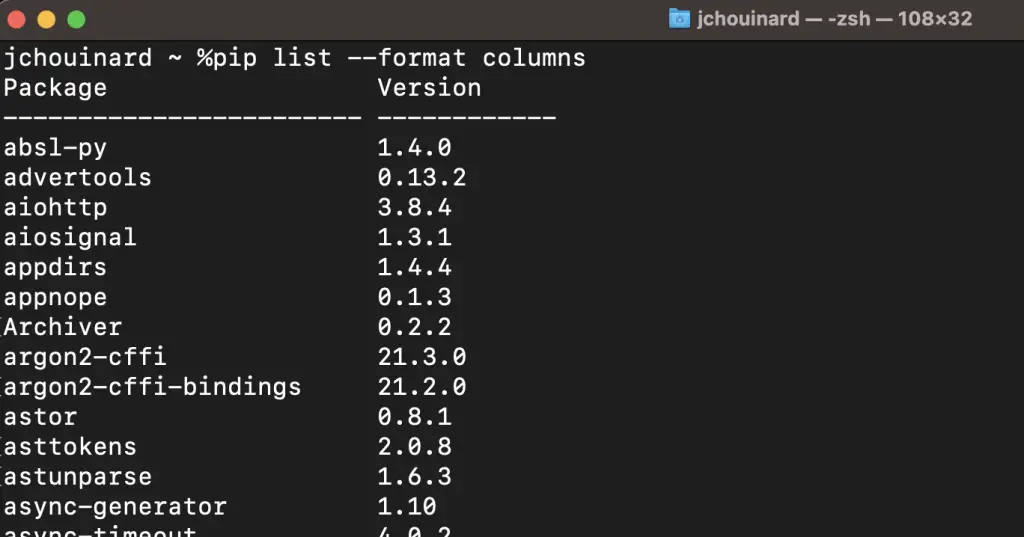In this tutorial, you will learn how to list every Python packages installed in your environment, whether you are using pip, conda or pipenv package management systems for Python.
Follow this article for those interested in learning how to use pip to install and manage Python packages. For those interested in how to use the command prompt.
Cheatsheet on how to List Installed Packages in Python
| Package Manager | Command to list installed Package |
|---|---|
| pip | $ pip list |
| Anaconda | $ conda list |
| Pipenv | $ pipenv lock -r |
| Python Console | >>> import pkg_resourcesOR >>> help("modules") |
How to List Installed Python Packages with Pip
List Installed Python Packages (pip list)
To view all the packages installed in a Python environment, use the pip list command.
$ pip listPackage Version
------------------------ ------------
advertools 0.13.2
pandas 2.0.1
pip 23.2.1
...List Installed Python Packages (pip freeze)
To list the installed packages without including the package management tools such as pip and setuptools by using the pip freeze command.
$ pip freezeThe output will show installed packages that are not package management tools.
advertools==0.13.2
pandas==2.0.1Difference Between pip list and pip freeze
The main difference between pip list and pip freeze is that pip freeze does not include packages used for package management, such as pip and setuptools.
For example, here are the outputs of pip list and pip freeze for the same Python environment.
Pip list
Package Version
------------------------ ------------
advertools 0.13.2
pandas 2.0.1
pip 23.2.1
...Pip freeze
advertools==0.13.2
pandas==2.0.1You can however, use the pip freeze –all flag to show all the versions including packages managers.
$ pip freeze --alladvertools==0.13.2
pandas==2.0.1
pip=23.2.1The other big difference is that pip freeze can be used to create a requirements.txt file.
$ pip freeze > requirements.txt$ pip install -r requirements.txtHere’s the official documentations for both commands:
Select the output format (pip list –format)
To select the output format, use the --format flag with the pip list command.
How to show the pip list output in columns
$ pip list --format columns
How to Show the pip list Output in the JSON format
$ pip list --format json
How to Show the pip list Output in the pip freeze format
$ pip list --format freeze
Pip list up-to-date packages (–uptodate)
To list only the up-to-date Python packages, use the pip list -u or --uptodate command flags.
$ pip list -u
$ pip list --uptodatePip list outdated packages (–outdated)
To list only the outdated Python packages, use the pip list --outdated or -o command flags.
$ pip list -o
$ pip list --outdatedNote that you cannot use the --outdated flag along with the freeze format.
ERROR: List format 'freeze' cannot be used with the --outdated option.Pip list packages not required by other packages (–not-required)
To list only the Python packages that are not required by other packages, use the pip list --not-required command flags.
$ pip list --not-requiredThe --not-required flag is useful to know if it is safe to uninstall a package without breaking the dependencies for other packages.
How to List Installed Python Packages without Pip
It is possible that you are not using the pip Python package manager in your project. You could be using Anaconda or Pipenv for example.
How to List Installed Python Packages with Console
To list all the packages installed using pip from the Python Interpreter console, import the pkg_resources library.
import pkg_resources
packages = pkg_resources.working_set
packages_list = ["%s==%s" % (i.key, i.version) for i in packages]
print(packages_list)

To list all the packages installed without pip from the Python Interpreter console use the help("modules") function. Beware this function can take a long time and also risk infinite loops in some cases.
>>> help("modules")

How to List Installed Python Packages with Conda
To list all the packages installed using the Anaconda, use the conda list command in the Anaconda Navigator.
$ conda listHow to List Installed Python Packages with Pipenv
To list all the Python packages installed, including all dependencies, in a pipenv environment, used the pipenv lock -r command.
$ pipenv lock -r
SEO Strategist at Tripadvisor, ex- Seek (Melbourne, Australia). Specialized in technical SEO. Writer in Python, Information Retrieval, SEO and machine learning. Guest author at SearchEngineJournal, SearchEngineLand and OnCrawl.